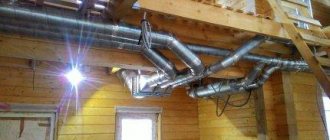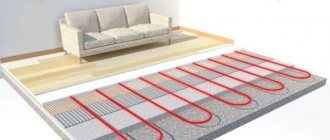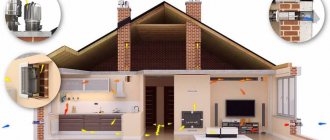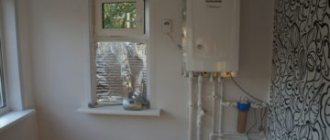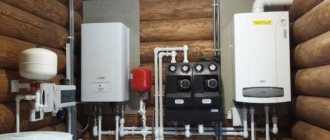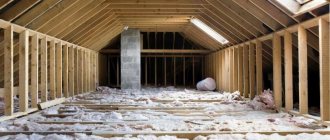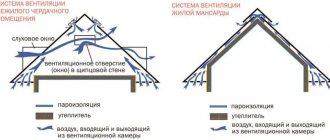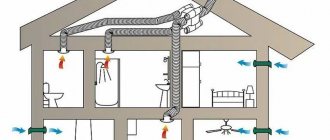The attic, despite the fact that it is used quite rarely, is still an important part of the house. Accordingly, it needs to be insulated, as this will help retain heat inside the room, especially in winter. Every homeowner remembers this. However, most people don't pay enough attention to attic ventilation. In fact, it allows you not only to maintain the air temperature, but also to maintain it in optimal condition.
But the main advantage of properly designed ventilation is that it does not allow condensation to accumulate, which significantly reduces the strength, and, consequently, the service life of the structure.
Why do you need attic ventilation?
The attic ventilation system in a private house is one of the main parts of the entire structure, thanks to which heat is exchanged. In summer, under the rays of the sun, a metal roof can heat up to over 150 degrees Celsius. Hot air enters the house, which leads to stuffiness.
However, this is not the only disadvantage of the absence of the described system. In winter, when the difference in temperature outside and indoors is quite high, condensation appears in the ventilation of a private house. Only a well-designed system can provide good ventilation.
Climate
It is unlikely that anyone will dispute the need to insulate the attic to ensure a comfortable atmosphere in the house in winter. But for some reason, many people forget about ventilation in order to maintain a constant temperature regime. Meanwhile, proper attic ventilation not only maintains a constant microclimate, but also helps to increase the life of the roof and prevents the appearance of mold and mildew. Proper ventilation is just as important as good thermal insulation.
Content:
- Why is attic ventilation necessary?
- How to ventilate an attic?
- Cold attic ventilation
- Ventilation of a warm attic
- Attic ventilation in a house: myths and facts
- Important advice from professionals
- Ventilation of the under-roof space: video
Why is attic ventilation necessary?
Ventilation is an important design step that allows you to regulate heat transfer. In summer, the roof heats up to 160 degrees, and burning air enters the house. But this is not the only reason for concern. During the cool period, condensation accumulates on insulated floors, destroying the wood. Ventilation will help avoid premature wear of the rafters.
The ventilation system is aimed at mixing the temperature of the external environment and the roof and prevents the appearance of ice, huge icicles and an “avalanche” during snow melting. As you can see, the issue of arranging a reliable air exchange system is really important.
How to ventilate an attic?
The attic can be cold or warm. The first option is traditional. In this case, the rafter system is not protected in any way, since only the ceiling is insulated. The second is an echo of the Soviet period, pursuing the sole goal of protecting utility lines.
Cold attic ventilation
Ventilation in cold attics must be controlled. To do this, it is necessary not to cover the sheathing and rafters. An alternative may be lining with gaps to ensure unhindered air circulation. If ondulin or slate is laid on the roof (in the absence of wind and vapor barrier films), there is no need to worry - air freely penetrates between the waves of the roof into the attic and goes out.
It is important! Metal tiles are also ventilated, but can form condensation, which means covering the film becomes mandatory.
If the roof is gable, then the ventilation ducts are located in the gables. A fairly effective solution is loose fitting lining of wooden overhangs. Uniform distribution of narrow slots promotes effective ventilation of the entire attic.
However, if the junctions and lining are tightly fitted or the gables are made of stone, then it is necessary to make holes in the walls. They should be on opposite sides, which will help eliminate stagnant areas.
It is important! The total area of ventilation ducts is calculated based on 0.2% of the total floor area.
There is also a more economical option - installing standard ventilation grilles. One grid should be adjustable, the other should be turned with the holes down. A mosquito net will protect you from insects.
For a hip roof, ventilation arrangements will follow a different scenario. The inlet hole is made from below (in the hem), and the outlet is made from above, at the ridge. If the overhang lining is made of wood, then the beams can be placed not quite tightly, with an interval of several millimeters. When sewing with plastic, individual components must have holes. Such panels are called soffits.
What to do if the binder is already assembled and tightly packed? There is also a way out of this situation - the production of gratings with a mesh with a diameter of 5 cm. They are usually located along the length of the wind overhang in increments of 80 cm. To make holes you will need a drill with a round drill. The top output is made from the top. Please note that a lot will depend on the type of roof.
For a flexible roof, install a valve (turtle) or a ventilated ridge. For slate and euroslate - a classic strong point. For ceramic tiles - a special valve. Metal tiles can be ventilated using a standard ridge. It is worth noting that a ridge is not only a financially beneficial replacement for a valve, but also an opportunity to equip a ventilation system in the shortest possible time.
Some people practice installing dormer windows (you can glaze them, or you can put bars on them), but such a task is difficult to implement and requires theoretical and practical training.
Ventilation of a warm attic
Natural circulation is practically not used in heating systems today. This means that when planning to convert an attic into a living attic, the roof should be fully ventilated. For sheet metal and flexible tiles, it is necessary to arrange a ventilated area - sew a counter batten onto the rafters. Windproof films are preferred for metal roofs. For a slate roof, counter battens are not necessary, because air must flow freely from bottom to top. The entrance is made in the filing, and the exit is through the ridge.
Cold attic ventilation
Ventilating a cold attic is a fairly lightweight design that you can do yourself without any problems. To design and create a system, you need to know the basic aspects of the theory and have basic skills.
Creating a ventilation system in a cold attic in a private home is an easy task. It works due to the large volume of air and the absence of any obstacles to its normal circulation. The described ventilation method can be created by ensuring ventilation of the attic using several structures: eaves overhang, gable windows, grilles, roof ridge and ridge, etc.
For rooms with a gable roof, the best option would be to choose gable windows or eaves overhangs. They are best suited for designing an attic ventilation system with this type of roof.
If your cash reserves are quite meager, then as a budget alternative, you can use the option of using conventional grilles. Usually, they are installed in the amount of two pieces, where one can be adjusted, and the second is static, but at the same time the vents face downwards. As an additional accessory, a mosquito net can be attached to them, which will block access to insects.
The hip roof structure does not have gables. Therefore, to create a ventilation system, only cornice overhangs can be installed on them. In this case, the air is exhausted through the roof ridge.
The most difficult situation arises when working with valleys. Due to their specific design, it is quite difficult to ensure ventilation when working with them. However, this can be done using spot cornice aerators.
Through the dormer windows
There are many ways to ventilate your attic. One of the most commonly used is the design technique using a dormer window system. This design eliminates the need for additional holes, vents, cracks, etc.
Many experts note that the use of special dormer windows is not effective enough to ensure full air circulation in the attic, but they are quite sufficient to combat condensation.
If you want to create attic ventilation with your own hands using dormer windows, then you need to follow the following rules:
- the minimum dimensions of each window should be 60 by 80 cm;
- installation of dormer windows should be carried out strictly on opposite gables;
- relative to the eaves and edges of the attic, they should be located in the middle;
- the minimum distance between two holes must be at least one meter;
- Each window is installed directly into the grille itself.
The method described above is most common in the construction of country cottages. However, it has a significant drawback. If low-quality building materials are used, air will accumulate under and above the dormer window, which in turn will interfere with ventilation. You can install dormer windows yourself. It is enough to study a little theory and have basic construction skills.
Products
Roof vents are special openings that can be used to create ventilation in both a thermal and cold attic. There are two types of vents: ridge and cornice.
Ventilation of the attic of a house, made using the first type, consists of small slots, up to 5 cm wide. They are located along the perimeter at a distance of at least eight meters from each other.
Attic ventilation using vents under the eaves are gaps located between the roof and the wall. Their width is approximately 2 cm. An alternative option is a point arrangement.
The size of the hole depends on the slope of the slope, but the diameter cannot be greater than 2.5 cm. Designing attic ventilation using vents is the only technique that can be performed without the use of dormer windows.
Ventilation aerators
Roof aerator - relative to other devices, this is a fairly new type of vent. Externally, it looks like a pipe, the top of which is covered with a special “hat”.
The attic ventilation system of a private house, based on them, does an excellent job of removing steam, moisture and stagnant air, providing high-quality cold-type attic ventilation.
Aerators are installed on roof slopes, since in these places air moves due to the existing difference between temperature and pressure. Thus, they replace ridge vents. Aerators are divided into point and continuous. The first ones are equipped with special fans.
The continuous type is a plate with holes located along the ridge. Due to the fact that it is covered from above by the roof of the attic roof, it is practically invisible, but the ventilation of the room is carried out efficiently.
Depending on the material from which the roof of the attic is made, it is necessary to use different aerators. There are four types in total, each of which is designed for a specific roof:
- from bitumen shingles;
- from metal ceramics;
- made of ceramics;
- and also for flat roofs.
Aerators need to be installed in places where eaves vents are provided. In addition, when installing them, several conditions must be met:
- the roof slope should be in the range from 15 to 45 degrees;
- aerators must be installed at a distance of at least 30 cm from the chimney and walls;
- they should protrude from the roof ridge slot by 25 cm;
- point-type models are installed more than half a meter from the ridge.
System of dormer windows and vents
One of the common measures for arranging attic ventilation in a private house is air exchange carried out by dormer windows. In this case, you don’t need to use a system of holes, vents and gaps. According to experts, this method is not extremely effective, but condensation does not accumulate in the room. The rules are as follows:
- The size of such windows should be at least 60x80 centimeters.
- Windows are installed on opposite gables.
- The windows are placed at an even distance from the cornice, the sides of the building and the ridge.
- The distance between two adjacent windows is at least one meter.
- The window can be installed directly into the ventilation grille in the attic.
This method of air exchange is popular in the construction of dachas and country houses. But there is also a disadvantage of such a system: air can stagnate under the dormer window and above it. But if you choose high-quality building materials and carry out the installation correctly, condensation will not accumulate in the attic space. Another, simpler way is to place vents. So how to create ventilation yourself, without resorting to the help of specialists?
In a private house, you can do the ventilation of a cold attic yourself. Evidence that condensation has accumulated is the appearance of an unpleasant smell of mustiness and dampness. Violation of comfort prompts many to immediately take up tools and begin fixing problems. In order for the ventilation system to ensure optimal air exchange, condensation does not accumulate and heat loss does not occur, it is important to pre-design all elements. If the roof is gable, the arrangement will not raise questions or problems. After the planning stage, you can start working:
- Vents are made in the gables.
- Wind slopes are covered on the sides of the roof with wood.
- All cracks are made uniformly, creating airflow over the entire surface of the attic.
Important! If the gables are made of stone, then there can be no gaps, and, armed with a tool, you need to make a couple of dormers in the surface.
Ventilation of a warm attic
Modern heating systems very rarely use a natural air circulation system. Therefore, when converting an attic space into an attic, it is necessary to ensure absolute ventilation.
For a roof made of sheet metal and flexible tiles, it is necessary to sew counter battens, rafters and sheathing. Ventilation of a warm attic, the roof of which is made only of metal, is carried out using specialized windproof films - geosynthetics.
For roofs covered with slate, the use of counter battens is not necessary, since the attic will be ventilated in the same way as in other rooms.
Basic SNiP requirements for ventilation systems
The requirements of SNiP can be considered redundant, but they still need to be fulfilled. They clearly prescribe not only the minimum required air exchange for each room, but also regulate the characteristics of each of the system elements - air ducts, connecting elements, valves.
The required air exchange is:
- for the basement - 5 cubic meters per hour;
- for living rooms - 40 cubic meters per hour;
- for the bathroom - 60 cubic meters per hour (plus a separate air duct);
- for a kitchen with an electric stove - 60 cubic meters per hour (plus a separate air duct);
- for a kitchen with a gas stove - 80 cubic meters per hour with one working burner (plus a separate air duct).
It is logical to equip the bathroom and kitchen with a forced ventilation system, even if natural ventilation is sufficient for the rest of the house. Exhausting air from the basement to avoid the concentration of carbon dioxide, which is heavier than air, is also often provided by a separate air duct.
The air circulation diagram in the house, made in the style of infographics, gives an idea of the flow of air flows. It is very important to check the functionality of the system after installing the duct system
Homeowners who are not ready to turn the roof of their house into a palisade of air ducts often think about how best to arrange ventilation communications within the attic. After all, I would like the design not to be too bulky.
Attic ventilation
Attic ventilation is a more complex design than the ventilation system for a cold attic. The layers should be located between the rafters, and the space between the bottom and top surfaces of the insulation and heat retaining material should be at least 2-3 cm.
It is difficult to do attic ventilation with your own hands, but if you have the necessary theoretical knowledge and skills, it is quite possible. One of the common difficulties is the situation when the depth of the rafters used is not enough to provide the required gap between the materials. In this case, additional space is created by boards and slats.
This is easy to do on simple shaped roofs. However, if your attic is not standard, then the best way out of the situation is to use special diffusion membranes. Their advantage is that they will provide high-quality ventilation of the room even if they are located directly on the thermal insulation layer.
You can add space to the ventilation system in the attic with your own hands. This can be done using a special crate. Its thickness should be at least 5 cm. In this case, air for ventilation will be taken in through special soffits, and will leave the room in the standard way - through the end of the roof.
Roof ventilation methods
To carry out air circulation in the under-roof space, use:
- roof ventilation outlets;
- piece roof covering with ventilation holes;
- roof fans;
- ventilation gap of the roofing pie;
- dormer windows.
Now there are many roof outlets and ventilation vents of continuous and point type.
Aerators for continuous roof ventilation Source kanalizaciyavdome.ru
Continuous aerators include ridge and cornice vents; combining them brings maximum efficiency.
The operation of this scheme is based on wind and heat pressure. When roof ventilation is performed correctly, within an hour the air flow passes through the entire roof surface twice.
At the top, vents are applied with roofing material so that they do not spoil the appearance and do not allow precipitation to pass through.
How to insulate
The pipe system must be insulated, especially when designing the attic ventilation of a bathhouse or sauna. This is necessary to prevent condensation from accumulating on the internal walls. Due to the fact that the pipe connections are not airtight, it is necessary to provide additional insulation for the ventilation in the attic.
The fact is that the appearance of condensation in ventilation ducts is inevitable. People exhale, use hot water, wash, etc. - all this leads to the release of copious amounts of moisture. In particular cases, the level of relative humidity can reach one hundred percent, which naturally affects the integrity of both the ventilation system and the attic as a whole.
To avoid this, you need to insulate the pipes using special materials. For this you can use polystyrene foam, mineral wool, various geosynthetics, etc.
Preparation for work
Before starting work in the attic of a wooden house, you need to check the joints of the floors
It is important to note: there should be no gaps or cracks on the base. Any gap is blocked using lime mortar and tow.
Frame elements are impregnated with antiseptic compounds and fire retardants.
If ventilation ducts have not been created before, the time has come to make them.
If you plan to make insulation using a roll scheme, you need to equip the floor slabs with logs (special bars). To secure them, concrete screws or dowels can be used.
When you plan to turn the attic into an attic, the heating pipes must be insulated. The following types of technical wool are best suited for them:
- glass;
- mineral;
- slag;
- stone;
- basalt.
Please note: the cheapest options should be used in areas with mild winters. If the frosts are severe enough, you will have to buy more expensive and reliable insulation.
It is necessary to clean the surface as much as possible from the slightest traces of dust and other contaminants. All areas of heating systems are overlapped at least twice with protective materials.
Calculation of attic ventilation
For those who decide to make a ventilation system in the attic of a private house on their own, before starting the installation procedures, you need to familiarize yourself with the calculation method and perform it. Only a professional can guarantee the maximum level of quality of the created project. However, there are several rules that, if followed, will allow you to ensure that your attic is well ventilated.
For every 1000 square meters, there should be two square meters of ventilation holes. In special cases, you can use a ratio of 1 to 300. It is important to understand that in the calculation process it is necessary to use values that do not take into account the width of the grilles and the length of the fins, even though they disrupt the natural movement of air flows.
Naturally, exceeding the size of the vents made will also negatively affect the quality of the ventilation system, as will their lack. Large openings may allow snow, water, etc. to enter.
Why don't many people ventilate their roofs?
The fact is that most developers, having made every effort to seal the roof and the house itself, do not even think about where the moisture comes from in a sealed room, especially in a cold and uninhabited attic under the roof. And the whole point is that warm air always rises - this is junior physics. There is always moisture in the air mixture - this is also understandable. But many people forget that the next barrier to moisture is the vapor barrier, through which it “happily” passes under the roof. Moist warm air passes through building materials such as brick and foam concrete. Accumulating in the under-roof space, during the first cold snap, moisture condenses on the materials, which leads to a loss of their effectiveness. In summer, an unventilated roof becomes very hot, which causes serious discomfort. This is especially true for the lack of ventilation of a metal roof.
Important! If moist air is not removed from the roof space, this will inevitably lead to the gradual destruction of the entire roofing pie.
The benefits of proper ventilation
- Freely “walking” air promptly removes warm, moisture-saturated air from the attic in a natural way.
- The attic, and at the same time the roofing pie, are in a dry state.
- The load-bearing parts of the roof are not subject to rotting.
- Ventilation on the roof of a private house helps preserve all roofing materials.
- Ventilation in the summer prevents the roof from heating up too much.
Common Misconceptions
There are quite a lot of stereotypical misconceptions about the design and installation of attic ventilation systems. Oddly enough, most people actually believe these myths to be true. The main ones are as follows.
- There is an opinion that in the winter season, when air temperatures are below freezing, heat escapes from the house through the ducts of the ventilation system. In fact, heat will only escape from the house through ducts if the system is designed incorrectly or poorly. The real source of this problem is poor insulation material that allows moist air currents into the attic space. Consequently, this leads to the formation of condensation, which in turn affects the integrity of the roof.
- Some people are sure that the ventilation system is only relevant in hot weather. In fact, it works at any time of the year. In hot weather, the system promotes air circulation, which prevents stuffiness from forming. In winter, with high relative humidity, it prevents the formation of fungus and icicles.
- Very often, when designing an attic ventilation system, people do not pay due attention to the size of the ventilation openings. As already mentioned, it is possible to create a high-quality, high-quality project only if the correct calculations are carried out. With a chaotic choice of the size and location of the holes, most likely, the ventilation efficiency will be zero. The average ratio of vents to ceilings should be 1 to 500.
Main functions
The process of air exchange in a room consists of regulating heat exchange processes and maintaining optimal environmental indicators - temperature, humidity level, speed of movement of air masses.
The engineering system, equipped in accordance with established technical requirements, ensures the free flow of air and its movement in space due to installed dormer windows, vents, aeration devices of various designs and other openings.
The device of normally functioning ventilation is necessary especially if equipment for a supply and exhaust ventilation system or ducted air conditioner is located within the non-residential space. If the condensate that settles on it is not drained in a timely manner, repairs will have to be done very often.
The functional purpose of the system is the regular supply of the required volume of air and its subsequent removal, which contributes to:
- reducing moisture in the room;
- providing the necessary microclimate;
- preventing the formation of condensation and the development of fungus;
- creating continuous air exchange;
- preventing deformation of rafters in the building.
The organization of ventilation should be carried out both in a warm and in an uninsulated attic. In the summer, the roof surface heats up to high temperatures, transferring most of the heat to the lower part of the house.
In the presence of ventilation devices, the temperature inside the entire building decreases, which reduces the load on the air conditioning system, if present.
High humidity in the autumn-winter period affects the microclimate of the attic. At the same time, the thermal insulation qualities of the structure will be significantly reduced, because the water contained in the insulation and materials will contribute to heat loss. Therefore, an air exchange system is equipped to remove excess moisture.
Due to the large temperature difference inside and outside the room, condensation forms, walls, floors, floor beams, rafters, mauerlat, and vertical posts become wet. All this leads to rotting of the wooden components of the roof and the appearance of dampness.
Due to the difference between the temperature outside the roof and within the attic space, condensation forms on the inner surface of the roof or in the insulation. It must be removed through ventilation
To effectively ventilate the room throughout the year, without loss of heat in the house, the following technical standards are provided: for every 500 m2 of room, 1 m2 of ventilation openings is required.
In addition, in order to prevent the formation of water droplets on the beams of the structure, insulation measures should be taken - installing steam and waterproofing.
Expert advice
Attic ventilation in a private house, designed independently, is quite a risk. So, as soon as a highly qualified professional can create a system that is guaranteed to provide good ventilation.
However, if you decide to create it yourself, it is strongly recommended to follow the following advice from experts.
- It is necessary to pay careful attention to the ventilation holes located along the perimeter of the attic roof ridge. In most cases, the standard method is used, which involves their location as close to the ridge as possible.
- The ventilation system must be designed to withstand all possible temperatures and weather conditions in your climate. This will guarantee a long service life of both the ventilation itself and the entire roof as a whole.
- An important condition without which to create a ventilation design that ensures high-quality ventilation of the room is that vents must be located inside the attic between the rafters. They must be placed in such a way that there is absolutely no chance of clogging or blocking air flow.
- In the case of installing continuous soffits under the eaves, it is also necessary to additionally install a specialized screening mesh. It is made of aluminum or plastic. Both materials are absolutely resistant to corrosion.
- If you plan to install a supply-type ventilation system, then it should be located in the cleanest area of the room.
- The pipes of the system must be covered with diffusers or grilles.
Thus, having minimal theoretical knowledge and basic work skills, following the tips described above, you can create a high-quality ventilation system that will provide good ventilation without any problems. When developing a project, you need to carefully calculate the number of holes to maintain their ideal ratio to the area.
